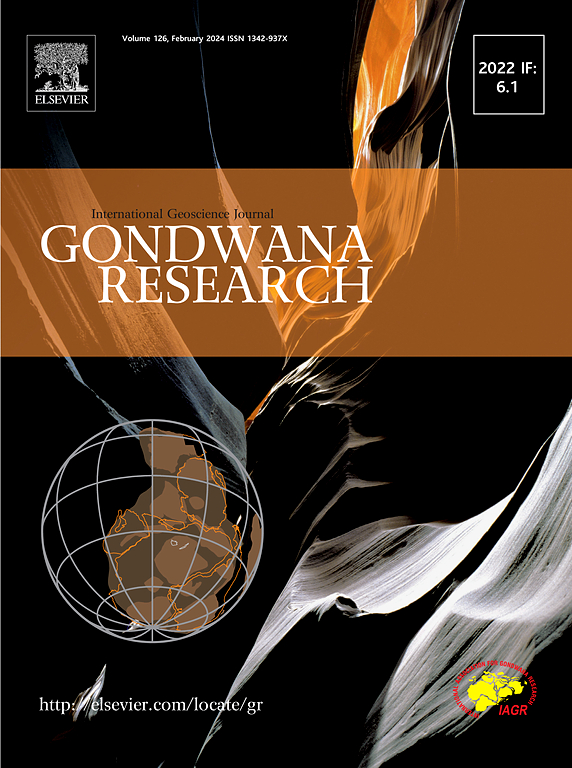Granitoid genesis and related rare metal mineralization of the Shihuiyao Rb–Ta–Nb deposit in the Southern Great Xing’an Range, NE China
IF 7.2
1区 地球科学
Q1 GEOSCIENCES, MULTIDISCIPLINARY
引用次数: 0
Abstract
The Shihuiyao deposit, located in the southern Great Xing’an Range (SGXR) in China, is an important Rb–Ta–Nb polymetallic deposit hosted by Li–F-bearing granites in the eastern portion of the Central Asian Orogenic Belt. However, its emplacement history and petrogenesis, and mechanisms of rare metal enrichment remain controversial. This study presents a systemic petrographic, geochronological, mineralogical, and geochemical study on mineralized amazonite-bearing albitized granite, albitized granite, and greisen, as well as barren biotite granite in the Shihuiyao deposit. Uranium–Pb geochronological results for zircon, columbite-group minerals, and cassiterite demonstrate that both emplacement and mineralization occurred between ca. 145–140 Ma. The high TE1,3 values, and low Zr/Hf and Nb/Ta ratios of the biotite granite suggest that it crystallized from a highly evolved magma. Based on the late-stage crystallization of Fe-rich biotite, the depleted εHf(t) values of zircon (+6.5 to + 8.3), and the elevated bulk-rock F and alkali contents, it is inferred that the parental magma to the biotite granite originated from the partial melting of residual granulite-facies rocks within the lower crust. The distinct Zr/Hf, K/Rb, and Y/Ho ratios of barren and fertile granitoids suggest that they evolved independently as these ratios typically vary continuously within a magmatic system. The presence of snowball quartz, fluorite, and topaz suggest that the mineralized granites formed within a magmatic–hydrothermal system enriched in Na, F, and H2O. Such a Na-, F-, and volatile-rich melt (represented by the magma parental to the ore-bearing granitoids) would have separated from a conventional silicate melt (represented by the magma parental to the biotite granite), generating a scenario in which two immiscible silicate melts were present (melt-melt immiscibility). The increasing bulk-rock concentration of Rb, Ta, and Nb from the barren biotite granite to the fertile (amazonite-bearing) albitized granite indicates that melt–melt immiscible processes led to a significant enrichment of rare metals.

大兴安岭南缘石辉窑Rb-Ta-Nb矿床花岗岩成因及相关稀有金属成矿作用
石辉窑矿床位于中国大兴安岭南段,是中亚造山带东段一个重要的含li - f花岗岩型Rb-Ta-Nb多金属矿床。但其侵位历史、成因、稀有金属富集机制等仍存在争议。本文对石会窑矿床中含矿化amazonite的钠长岩花岗岩、钠长岩花岗岩、灰长岩以及黑云母花岗岩进行了系统的岩石学、年代学、矿物学和地球化学研究。锆石、柱长石群矿物和锡石的铀- pb年代学结果表明,侵位和成矿发生在约145-140 Ma之间。黑云母花岗岩的高TE1、3值、低Zr/Hf和Nb/Ta比值表明它是由高度演化的岩浆结晶而成。根据富铁黑云母的后期结晶、锆石的εHf(t)值(+6.5 ~ + 8.3)的亏缺以及大块岩F和碱含量的升高,推测黑云母花岗岩的母岩浆来源于下地壳残余麻粒岩相岩的部分熔融。贫花岗岩和富花岗岩的Zr/Hf、K/Rb和Y/Ho比值不同,表明它们是独立演化的,因为这些比值在岩浆系统中通常是连续变化的。雪球石英、萤石和黄玉的存在表明,矿化花岗岩形成于富含Na、F和H2O的岩浆热液系统中。这样一种富含钠、氟和挥发物的熔体(以含矿花岗岩的岩浆母体为代表)将与传统的硅酸盐熔体(以黑云母花岗岩的岩浆母体为代表)分离,从而产生两种不混溶的硅酸盐熔体(熔体-熔体不混溶)。从贫瘠的黑云母花岗岩到肥沃的(含亚马逊石的)钠长化花岗岩,Rb、Ta和Nb的块状岩石浓度增加,表明熔融-熔融不混溶过程导致了稀有金属的显著富集。
本文章由计算机程序翻译,如有差异,请以英文原文为准。
求助全文
约1分钟内获得全文
求助全文
来源期刊

Gondwana Research
地学-地球科学综合
CiteScore
12.90
自引率
6.60%
发文量
298
审稿时长
65 days
期刊介绍:
Gondwana Research (GR) is an International Journal aimed to promote high quality research publications on all topics related to solid Earth, particularly with reference to the origin and evolution of continents, continental assemblies and their resources. GR is an "all earth science" journal with no restrictions on geological time, terrane or theme and covers a wide spectrum of topics in geosciences such as geology, geomorphology, palaeontology, structure, petrology, geochemistry, stable isotopes, geochronology, economic geology, exploration geology, engineering geology, geophysics, and environmental geology among other themes, and provides an appropriate forum to integrate studies from different disciplines and different terrains. In addition to regular articles and thematic issues, the journal invites high profile state-of-the-art reviews on thrust area topics for its column, ''GR FOCUS''. Focus articles include short biographies and photographs of the authors. Short articles (within ten printed pages) for rapid publication reporting important discoveries or innovative models of global interest will be considered under the category ''GR LETTERS''.
 求助内容:
求助内容: 应助结果提醒方式:
应助结果提醒方式:


